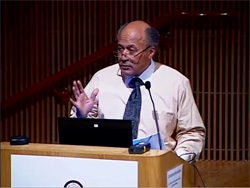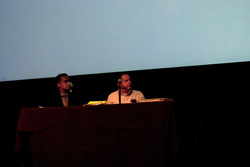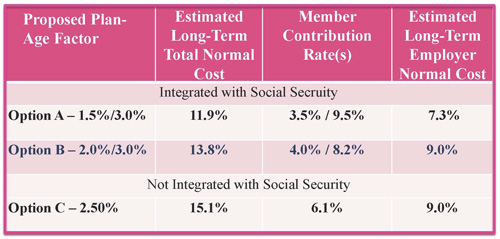Proposed Changes in Post-Employment Benefits Discussed at Town Hall
Ioana Patringenaru | Oct. 25, 2010

Click here to watch a town hall on post-employment benefits that took place at the Hillcrest Medical Center Friday. Video
Keep up with the latest news and events at the Future of UC Retirement Benefits website.
The cost of retirement benefits and the future of the University of California were on the minds of about 200 members of the UC San Diego community who turned out for a town hall about post-employment benefits held at the Price Center Friday. Another 75 attended a town hall at the Hillcrest Medical Center earlier in the day.
The meetings were part of a series of discussions held throughout the UC system in recent months to consider recommendations to change retirement benefits for employees hired after July 2013. The recommendations were made by a special task force comprised of more than 40 faculty, staff, retirees and administrators, that examined the future of UC’s retirement plans.
“The question is sustainability, the question is affordability, the question is competitiveness,” Randy Scott, UCOP’s executive director of talent management and staff development said at Friday’s town hall.
The
changes in the design of the retirement plans will not affect current UC employees, Scott stated repeatedly during the town hall. “The vested benefits in UCRP are constitutionally protected,” he said, referring to the California constitution.
The task force outlined three different options for future retirement plans for new employees, with different benefits and different levels of contributions for both employees and employers. UC President Mark Yudof is set to recommend one of the options soon. The town halls are designed to gather input from employees before the Board of Regents discusses retirement changes at their November meeting and votes to choose one of the options at a special December meeting. Any changes are subject to collective bargaining.
“You should ask yourself whether you believe you’ll be able to select one of these three options,” Chancellor Marye Anne Fox told audience members Friday. “If the answer is no, you should seek more information.”

Peter Taylor, CFO of the UC system, left, and UCSD economist Ross Starr listed to a presentation during a town hall on post-employment benefits held at the Price Center Friday.
Both UC and UC employees didn’t contribute to UCRP for 20 years. Contributions resumed in spring of this year. Also, financial markets have taken a hit in recent years, while health care costs for retirees escalated. As a result, UC’s retirement system currently faces $12.5 billion in unfunded liabilities¾that will go up to $20 billion if no actions are taken.
Although the task force recommendations won’t affect the retirement benefits of current employees, members of the UC-wide and San Diego Academic Senates have expressed concerns about how the changes would impact UC’s ability to recruit and retain employees and the university’s future as a top research institution.
“We’re looking 10 to 20 years ahead and we’re asking what kind of institution UC is going to be,” said Ross Starr, a UCSD economist who sits on the advisory board for UC’s retirement system.
All three options put forth by the task force would allow employees to become vested after five years of service; raise the minimum retirement age from 50 to 55; and make employees eligible for the maximum pension benefit at age 65, documents show.
“We’re really, really trying to design a program that gives people 80 to 85 percent of their salary after a full career at UC,” said Peter Taylor, UC’s chief financial officer and executive vice president.
The options are increasingly more expensive, but provide increasingly higher benefits. Two options take into account Social Security income when calculating how much retirement income faculty and staff will need. Under both options, employees who earn less would pay lower percentages than employees who earn more.
The third option doesn’t take Social Security into account and proposes that all employees pay the same percentage of their salary into the retirement fund. As a result, it would cost some employees more every year, but also provide a higher pension benefit.
All faculty and staff representatives on the task force’s work groups signed a dissenting statement, saying that one of the options, known as Option A, was unacceptable because it does not provide adequate benefits and is not competitive. They also felt that as contributions to UCRP increase for current employees, they should be limited to no more than 7 percent of employees’ salary.

A table summarizing the three retirement plan options the task force crafted.
Courtesy UC Academic Senate
Current UCRP funding formula = years of service x highest average salary over three years x age factor (roughly 1.1 to 2.5%)
At Friday’s town hall, several audience members expressed concerns about the changes, including the increase in UCRP contributions. Does UC have any plans to increase salaries, asked Charles Kaminski, an architect in the department of design and construction.
“It is absolutely a front-burner problem,” said Taylor, the UC chief financial officer.
Officials know that they’re asking employees to pay more for benefits while salaries aren’t increasing, which translates into a pay cut, said Scott, the UCOP human resources official. “There’s no question about this,” he said. “We have to address base pay.” President Yudof has strongly encouraged university officials crafting their budget proposal for the 2011-12 fiscal year to address this issue, Taylor added. Total remuneration is the bottom line, said Starr, the UCSD economist.
“We’re behind now,” he said. “We certainly need to catch up.”
The changes will have an impact on the community, even though they do not affect current employees, said Carolan Buckmaster, a staff research associate at the UCSD Moores Cancer Center. “Future employees are going to retire and they’re going to retire into poverty,” she said. “That affects the community.”
Alonso Noble, chair of the UCSD Staff Association and an assistant superintendent in Facilities Management, asked whether officials truly think the changes provide employees with competitive pay and benefits. In the long run, the new benefits will be competitive, said Taylor.
The town halls have helped shed light on employees’ questions and concerns, he added after the meeting. Many said that including Social Security income in calculations was confusing. Some also said they didn’t trust that Social Security would still exist when they retire, he said.
“Input like this is so valuable,” said Taylor.

|